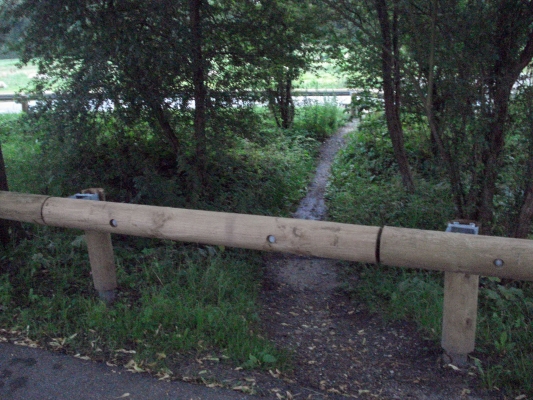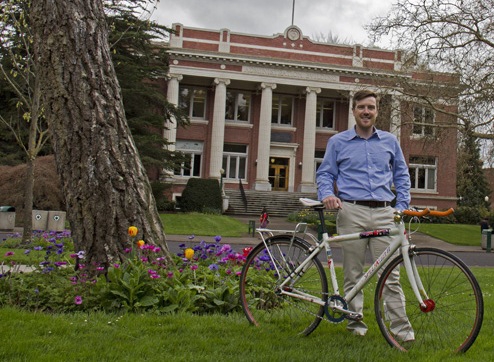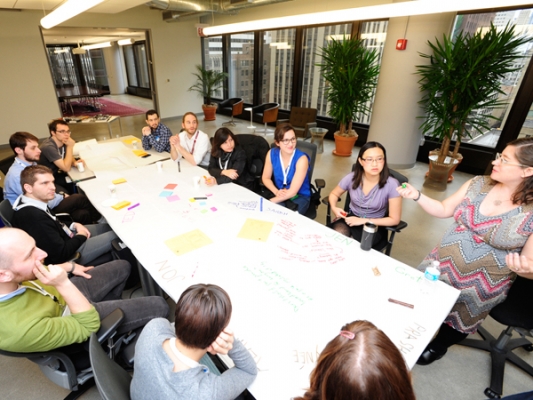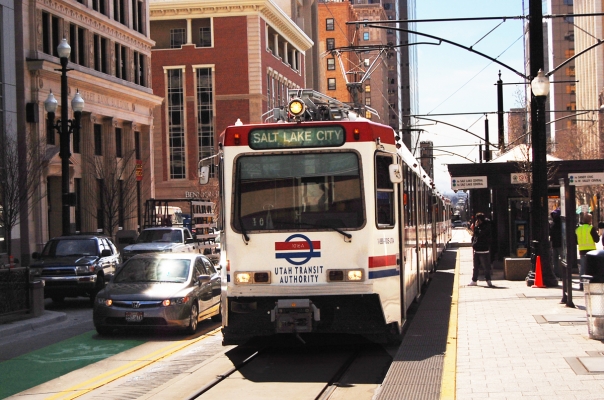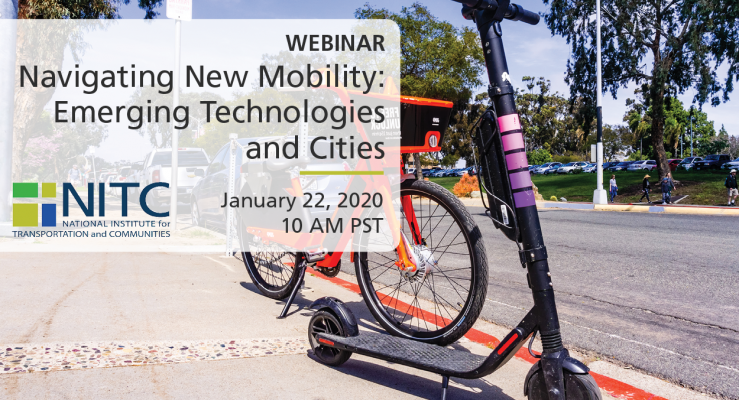University of Oregon Master's student Joe McAndrew was recently awarded an Eno fellowship and invited to participate in the 2013 Eno Leadership Development Conference.
The fellowship is an extraordinary opportunity for students on a career track to become transportation policymakers. Only 20 fellows nationwide are chosen each year, and only one student from each university transportation program can be nominated by their school. McAndrew attended the 21st annual conference in Washington, D.C. from June 2 to 6, all expenses paid.
"It was fabulous," said the second-year planning student from UO. In the course of the four-day conference he was able to attend a variety of panels and events, but said that for him, "the true highlight was just the people that we were able to meet."
Conference attendees included "high-level officials, executive directors from all sectors and levels of government," McAndrew said, "from the freight industry, which included trucks, rail, and port; to the airline industry, to Capitol Hill staffers... we also met with the executive directors from Parsons-Brinckerhoff, AASHTO and the like. It was an all-encompassing opportunity."
The Eno Center for Transportation is a non-partisan "think-tank" that promotes policy innovation in the field of transportation...
A new transportation class at the University of Oregon, launched in January 2013 and funded by grants from OTREC and NITC, by all accounts had a wonderful first term.
Conceived as part of the curriculum for the Oregon Leadership in Sustainability (OLIS) program at U of O, the course, titled Sustainable Transportation, will be a permanent part of the OLIS class roster and will be open to all graduate students at the university.
The class this winter, led by instructors Ann Scheerer and Larisa Varela, taught applied research in a real-world setting. Students worked on planning projects for the university and for its home community, the City of Eugene, Ore.
On March 20, 2013, U of O's Transportation and Livability Student Group, LiveMove, hosted a public event where students were invited to present their research and interested community members were invited to attend.
The day of the presentations in Eugene was exciting; the “icing on the cake” for Scheerer. Marc Schlossberg, OTREC/NITC executive committee member at U of O and faculty advisor for LiveMove, was there, and so were some professors from the planning department, staff from the sustainability office, and quite a few local transportation advocates.
Scheerer, a...
Read moreThe American Planning Assocation held its annual conference in Chicago this April.
Two OTREC universities sent students to attend, and OTREC staff member Jon Makler attended the Intelligent Cities "Unconference," which was held on Wednesday, April 17.
In addition to Portland State University graduate student research group Celillo Planning Studio, which won the APA student award for Application of the Planning Process, there were other PSU students who attended just to soak up the conference. Two students from the University of Oregon also attended and created a research poster for the conference.
This year's APA gave some focus to transportation. In addition to Monday, April 15 being themed "Transportation Day: Transforming Cities Through Transportation," there were also a handful of other transportation events including workshops titled "Sustainability Implications for Urban Transportation" and "Transportation Planning in a Changing Climate."
Makler, OTREC’s Education and Technology Transfer Program Manager, said that one of this year's highlights for him was the Unconference: a facilitated, participant-driven meeting which encouraged attendees to explore the ideas they were most interested in talking about. OTREC was one of about 25 organizations to take part in the Unconference.
...
Read moreOTREC has announced eight winners of the “Small Starts” grant program, which launched last December. These grants, made available through a new OTREC initiative, were intended to fund small projects related to transportation and community development. Any eligible professor at Portland State University, Oregon State University, the University of Oregon, or the Oregon Institute of Technology was invited to apply for a grant.
Priority was given to tenure-track faculty who are untenured, and faculty who have not received an OTREC grant in the past. The Small Starts program was conceived for the benefit of researchers who want the chance to undertake a small project that supports innovations in sustainable transportation through advanced technology, integration of land use and transportation, and healthy communities.
A total of $60,000 was available to be awarded; with no individual award larger than $10,000.
Interested faculty turned in their proposals by January 31, 2013. Here are the winners:
- Burkan Isgor, Oregon State University:
“Cracking Susceptibility of Concrete Made with Recycled Concrete Aggregates”
- Donald Truxillo, Portland State University, partnered with ODOT:
“Evaluation of ODOT's Ecodriving Program”
- Bob Bass, Portland State University, partnered with Drive Oregon:
“Impacts of Electric Vehicle Charging on Electric Power Distribution Systems “
- Nancy Cheng, University...
Staff from OTREC at Portland State University toured three partner campuses to prepare for the first round of projects under the National Institute for Transportation and Communities program, or NITC. Portland State, the University of Oregon, Oregon Institute of Technology and the University of Utah teamed up for the program, funded with a $3.5 million grant from the U.S. Department of Transportation.
The University of Utah was the first to receive a visit, March 19-20, in Salt Lake City. There, NITC executive committee member Keith Bartholomew hosted tours and meetings. Staff met with student representatives from various disciplines and with potential researchers from across campus before meeting potential community partners at the Utah Transit Authority offices. OTREC finance and communications staff members met with their University of Utah counterparts.
The meetings marked the first connection for much of the Utah faculty and OTREC staff. While the University of Oregon and Oregon Tech were already partners under the original OTREC grant, the NITC program marks Portland State and Utah’s first formal collaboration under the federal University Transportation Centers program.
On April 9, staff met with current and potential transportation researchers at the University of Oregon...
Read moreIn many cases, living in suburbia means relying on an automobile for most trips, even short trips to nearby stores. If housing developments incorporated better paths and sidewalks, however, would anyone use them?
Researcher Nico Larco found that people who live in well-connected developments are significantly more likely to walk and bicycle than those in developments only accessible by automobile. He details his findings in this OTREC report.
Larco, an assistant professor of architecture at the University of Oregon, found that people who live in well-connected developments walked to their nearby commercial strips nearly twice as often as did people in less-connected developments. In addition, a greater percentage of residents in well-connected developments reported sometimes walking or cycling.
Despite suburbia’s reputation for large single-family homes, more than a quarter of suburban housing units are higher density. In fact, the suburbs are home to more than 9 million multifamily housing units, with 5 million more projected for the last 20 years. Although these units tend to be near commercial centers, a lack of pedestrian and bicycle infrastructure makes trips using these modes difficult.
For this research project, Larco developed criteria for measuring connectivity in trips taken from, to and through multifamily suburban developments. Studied developments were rated as “well...
Read moredesignBridge is a student-based organization at the University of Oregon that exposes students to real architectural and planning projects in their community. The organization promotes studentsí engagement in their community while providing them with professional experience that will benefit them in their careers. In this OTREC-funded education project, led by Professor Nico Larco, the students of designBridge undertook the design and construction of a new transportation shelter for Roosevelt Middle School in Eugene, Oregon. The project results include not only the completion of the shelter but also the continued development of a service learning program that can effectively address small community transportation-related needs. To learn more about the project, down the final report at: https://ppms.trec.pdx.edu/docs/detail/2172
PRESENTATION ARCHIVE
OVERVIEW
Autonomous vehicles (AVs), e-commerce and the sharing economy are rapidly changing land use and transportation in cities. City leaders and professional planners are wondering how these technologies will change how they plan and operate cities. For the past year, the University of Oregon’s Urbanism Next Center and Sustainable Year Program focused staff and students on helping the cities of Gresham and Eugene better understand the potential impacts of a wide-range of topics and study a variety of potential responses to address the challenges and take advantage of the opportunities. These topics include issues related to safety, social equity, active transportation, sustainability and environmental impacts, design and management of the right-of-way, and the metropolitan footprint. In addition, the cities thought about city operations and budgeting and how they can inform decision-making, manage innovation, and consider the fiscal impacts and new mobility revenue.
During this webinar, the Urbanism Next researchers will discuss the research they conducted to help the cities navigate new mobility and emerging technologies. Researchers will...
Read more
